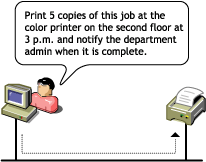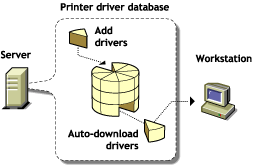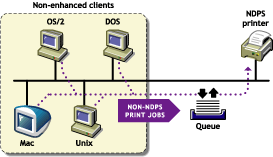

  |
NDPS is the default and preferred print system in NetWare. Novell's legacy, queue-based print system is also fully supported, which allows your users to continue printing as they always have until you complete the transition to NDPS. NDPS provides full support for IP-based as well as IPXTM-based printing, giving you a wide variety of system configuration options to fit your organization's specific needs.
Some of the most significant features of NDPS include the following:
Novell Distributed Print Services lets clients and printers exchange information about printers and print jobs. For example, this interchange allows users and administrators to get real-time information about a printer such as
For example, it reports such information as whether the printer needs toner or paper, whether it is online, and whether the lid is open.
For example, does it support color? Duplexing? How many pages has it printed since it was last serviced?
NDPS also lets you view information about a print job's properties and status, including
The bi-directional feedback provided by NDPS is limited only by the bi-directional capabilities of the printer itself. In many cases, NDPS actually enhances information provided about printers that do not have bi-directional capabilities.
With Novell Distributed Print Services, you can customize event notification. Event notification allows you to specify who should be notified of an event or problem, and how that person should be notified. It also allows you to identify the specific events or problems that you want notification messages sent for. For example, you can configure notification so that the owner of a print job will receive a screen pop-up message when the job has actually been printed.

You can also ensure that the printer operator is notified when a problem such as a paper jam occurs on the printer. Notification methods provided by NDPS include pop-up screen messages, e-mail, and log file records, while third-parties can develop other mechanisms such as beeper notification if they wish.
Novell Distributed Print Services is designed to take full advantage of Novell eDirectory. Integration with eDirectory allows you to create a single eDirectory object---an NDPS Printer object---to represent each printer on the network. As a Printer object, printers become as secure as the other objects in the tree, and they are just as easy to manage.
In the eDirectory tree, printers can be conveniently grouped. For example, you can group and manage all of your printers by department, workgroup, or location. You can also search for printers with specific capabilities, because those capabilities are properties of the NDPS printer object.
Not only does NDPS make printer management easier for you as an administrator, it also makes printing easier for end users. NDPS provides a database that includes drivers for most printers in common use today. From this database, you can select drivers you want to be automatically installed on client workstations when a user adds a printer. This eliminates the need for users to provide the printer driver themselves. You can add drivers to this database as they become available.

An NDPS client can also modify printer configurations. For example, a user can configure a printer to use a different size paper or to print a cover page. Users can change the properties of any installed printer that the administrator has not locked. Also, using NDPS, users can view the current status of any available printer to see how many print jobs are waiting to be printed before they send their jobs. These NDPS features help make end-user printing easier and more effective than the methods of the past.
From this list, you can select drivers you want to be automatically downloaded and installed on client workstations. You can add drivers to this database as they become available.
The NDPS interface supports many printer options in common use today, while the open architecture of NDPS allows printer manufacturers to add their own custom interfaces for specific printers. This means that as new printer features become available, you can access them through NDPS.
NDPS allows you to configure and schedule print jobs to be processed according to time of day, job size, or media availability.
The entire NDPS architecture is protocol independent. NDPS can be used in an IPX-based environment, a pure TCP/IP environment, or a combination of both. The third-party gateways being developed to work with NDPS are also protocol independent.
Most printers that support TCP/IP today do not have a discovery protocol like SAP for IPX-based networks. The Service Locator Protocol (SLP) will eventually be embedded in printers and will provide a discovery protocol that can be used with NDPS.
NDPS provides an enhanced Windows* client to take advantage of all of the advanced features provided by NDPS. All clients that are not NDPS-aware can still print to NDPS printers, and you can use all of your existing applications with NDPS. Although your queue-based print clients won't be able to take full advantage of the advanced features available in NDPS, they won't lose any of the printing ability they have now. This backward-compatibility feature of NDPS makes it well-suited for heterogeneous networks.

NDPS lets you preserve your investment in your existing printing resources. All clients can print to legacy printers. All currently available printers can be used in NDPS environments. In fact, major printer manufacturers have developed gateways for their existing printers to enable them to take advantage of many new features available with NDPS.
  |